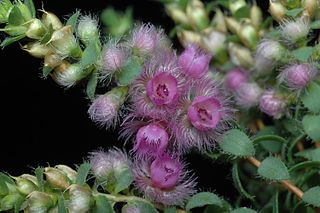Verticordia forrestii, commonly known as Forrest's featherflower, is a flowering plant in the myrtle family, Myrtaceae and is endemic to the north-west of Western Australia. It is a shrub with small, egg-shaped leaves and massed displays of scented pink to red flowers in spring.
Verticordia albida is a flowering plant in the myrtle family, Myrtaceae and is endemic to the south-west of Western Australia. It is a shrub with one main stem with many branches and spike-like groups of scented, white feathery flowers with a pink centre.
Verticordia aereiflora is a flowering plant in the myrtle family, Myrtaceae and is endemic to the south-west of Western Australia. It is a thin but bushy shrub with small leaves and greenish-yellow flowers with red spots and red fringes on the sepals.
Verticordia amphigia commonly known as pixie ears is a flowering plant in the myrtle family, Myrtaceae and is endemic to the south-west of Western Australia. It is usually an open, much-branched shrub with narrow leaves and yellow flowers which sometimes produce a "sea" of colour in the wild. The flowers are surrounded by boat-shaped bracteoles which give the plant both its common and scientific names.
Verticordia aurea, commonly known as buttercups is a flowering plant in the myrtle family, Myrtaceae and is endemic to the south-west of Western Australia. It is a slender, sometimes bushy shrub with a single stem at the base, cylindrical leaves and heads of scented, golden-yellow flowers in spring.
Verticordia auriculata is a flowering plant in the myrtle family, Myrtaceae and is endemic to the south-west of Western Australia. It is a small, multi-branched shrub with small leaves and spikes of pink to magenta-coloured flowers in late spring to early summer and it is widespread in the wheatbelt.

Verticordia blepharophylla is a flowering plant in the myrtle family, Myrtaceae and is endemic to the south-west of Western Australia. It is an erect, open shrub with a single main stem, leaves with hairy margins and pale to deep mauve-pink flowers and which occurs in an area between Perth and Geraldton.
Verticordia bifimbriata is a flowering plant in the myrtle family, Myrtaceae and is endemic to the south-west of Western Australia. It is an open shrub with small leaves and spikes of pink flowers.

Verticordia halophila, commonly known as salt-loving featherflower, or salt-loving verticordia, is a flowering plant in the myrtle family, Myrtaceae and is endemic to the south-west of Western Australia. It is an erect, bushy shrub with small, crowded, thick leaves and spikes of red and pink flowers in spring.
Verticordia centipeda is a flowering plant in the myrtle family, Myrtaceae and is endemic to the south-west of Western Australia. It is a shrub with a single stem at the base, small crowded leaves and greenish-pink flowers with a silvery fringe, in spike-like groups on the ends of the branches. It is common in areas around Geraldton.
Verticordia densiflora var. cespitosa is a flowering plant in the myrtle family, Myrtaceae and is endemic to the south-west of Western Australia. It is a shrub with small leaves and pink, or pink and white flowers. It is one of five varieties of the species Verticordia densiflora.
Verticordia fragrans, commonly known as hollyhock verticordia, is a flowering plant in the myrtle family, Myrtaceae and is endemic to the south-west of Western Australia. It is an openly branched shrub with egg-shaped leaves and spikes of sweetly scented, pink and white flowers in spring and early summer.
Verticordia luteola is a flowering plant in the myrtle family Myrtaceae, and is endemic to the south-west of Western Australia. It is a more or less openly branched shrub with crowded leaves on its side branches and spikes of pale yellow or bright pink flowers which turn cream to brownish as they age. This verticordia is a summer-flowering species.
Verticordia mitodes is a flowering plant in the myrtle family, Myrtaceae and is endemic to the south-west of Western Australia. It is a shrub with a single, highly-branched main stem, small leaves and small spikes of magenta-coloured flowers in late spring.
Verticordia paludosa is a flowering plant in the myrtle family, Myrtaceae and is endemic to the south-west of Western Australia. It is an openly branched shrub with small leaves and pink to magenta flowers with spreading, feathery sepals and erect, fringed petals in summer and autumn.
Verticordia serotina is a flowering plant in the myrtle family, Myrtaceae and is endemic to the north-west of Western Australia. It is a shrub with egg-shaped leaves and bright pink flowers with long, curved styles in spring.

Verticordia tumida, commonly known as summer featherflower, is a flowering plant in the myrtle family, Myrtaceae and is endemic to the north-west of Western Australia. It is an open shrub with very small leaves and clusters of deep pink flowers from late spring to early winter.
Verticordia vicinella is a flowering plant in the myrtle family, Myrtaceae and is endemic to the south-west of Western Australia. It is a shrub with narrow leaves and groups of small, scented, pink or pale yellow flowers, growing near Esperance and in the Cape Arid National Park.
Verticordia wonganensis is a flowering plant in the myrtle family, Myrtaceae and is endemic to the south-west of Western Australia. It is a shrub which grows near Wongan Hills and has a single main stem, small leaves and spike-like groups of large, pink, feathery flowers.
Verticordia × eurardyensis, commonly known as Eurardy magenta, is a flowering plant in the myrtle family, Myrtaceae and is endemic to a small area in the south-west of Western Australia. It is a shrub similar to both Verticordia dichroma and Verticordia spicata which grow in the same area and is thought to be a stable hybrid between those two species. It has mostly egg-shaped leaves and spike-like groups of dark magenta-coloured flowers which fade to straw-coloured, in late spring and early summer.




